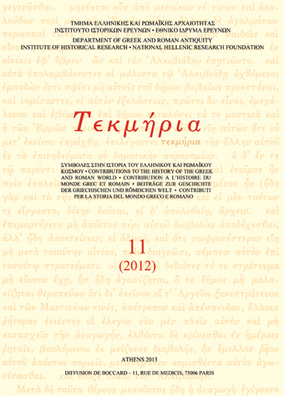Μακεδονικὰ ἐπιγραφικὰ ΙΙ
Part of : Τεκμήρια ; Vol.6, 2001, pages 134-148
Issue:
Pages:
134-148
Parallel Title:
Macedonica epigraphica II
Section Title:
Σύμμεικτα
Author:
Abstract:
The author republishes with new restorations and commentary a decreefrom Charakoma (modern Drymos) included the collection of M. Demitsas(Ή Μακεδονία έν λίθοις φθεγγομένοις και μνημείοις σωζομένοις, Athens1896, no. 682) and presents the editio princeps of an epitaph from Amphipolis,the text of which is known from its mention in the correspondence betweenthe Greek Consulate at Serres and the Greek Foreign Ministry (now in theMinistry's Historical Archive).Although the decree from Charakoma (dated on the basis of the letterforms to the second half of the 2nd cent. A.D.) is in a very fragmentary stateof preservation, its close study shows that it is concerned with the benefactionsof an anonymous citizen. From the words έπίταγμα and επιταγματα, thatrefer to all kinds of angariae imposed by the Roman authorities on theprovincial population, one may infer that the honored person covered theexpenses for all or some of them. The participle παραγενομενων (line 9) inconnection with the important position of Charakoma on the roads that led toKrestonia or to the Strymon valley, and the vicinity to the Via Egnatia make itprobable that these expenses were at least in part connected with the needs ofmilitary units or Roman officials that used these roads. The decree also refersto benefactions pertaining to public buildings (such as the Caesareum), butthe preserved fragment does not permit any determination of the nature andthe extent of the man's benefactions in connection with building activities.The city of Charakoma decided to have the honorary decree for theprominent citizen inscribed on a stone stele and erect the stele in a prominentplace, probably a sanctuary, where the same man's statue already stood. The funerary inscription from Amphipolis was found in 1899. It is dated tothe 277th year (ζοσ) which corresponds either to A.D. 129/130 (according tothe Macedonian provincial era) or to A.D. 245/246 (according to the Actianera). The nomen Grecinius which is attested here is also attested in two otherMacedonian inscriptions, one from Philippi, the other from Thessalonike. Theinscription from Philippi (1st or 2nd cent. AD) is a Latin funerary inscriptionplaced by C(aius) Graecinius Romulus Venustus on the grave of his parents.His family must have been important, since his father, Firminus, had held theoffices of a decurio and a questo in Philippi and that of a praefectus fabrum etfrumenti mancipalis provinciae Africae. The inscription from Thessalonike is alist of the members of a cult association of Zeus Dionysos Gongylos (secondhalf of the 2nd cent. AD); Grecinius Seleukos was one of the members. It isdifficult to determine the relationship between these citizens of three differentcities. But the vicinity of the cities, the rarity of the nomen, and the fact thatall these persons have the same praenomen suggest that the Caii Grecinii ofAmphipolis were relatives or freedmen of the wealthy family in Philippi, thatmoved to Amphipolis, possibly for financial reasons.
Subject:
Subject (LC):




